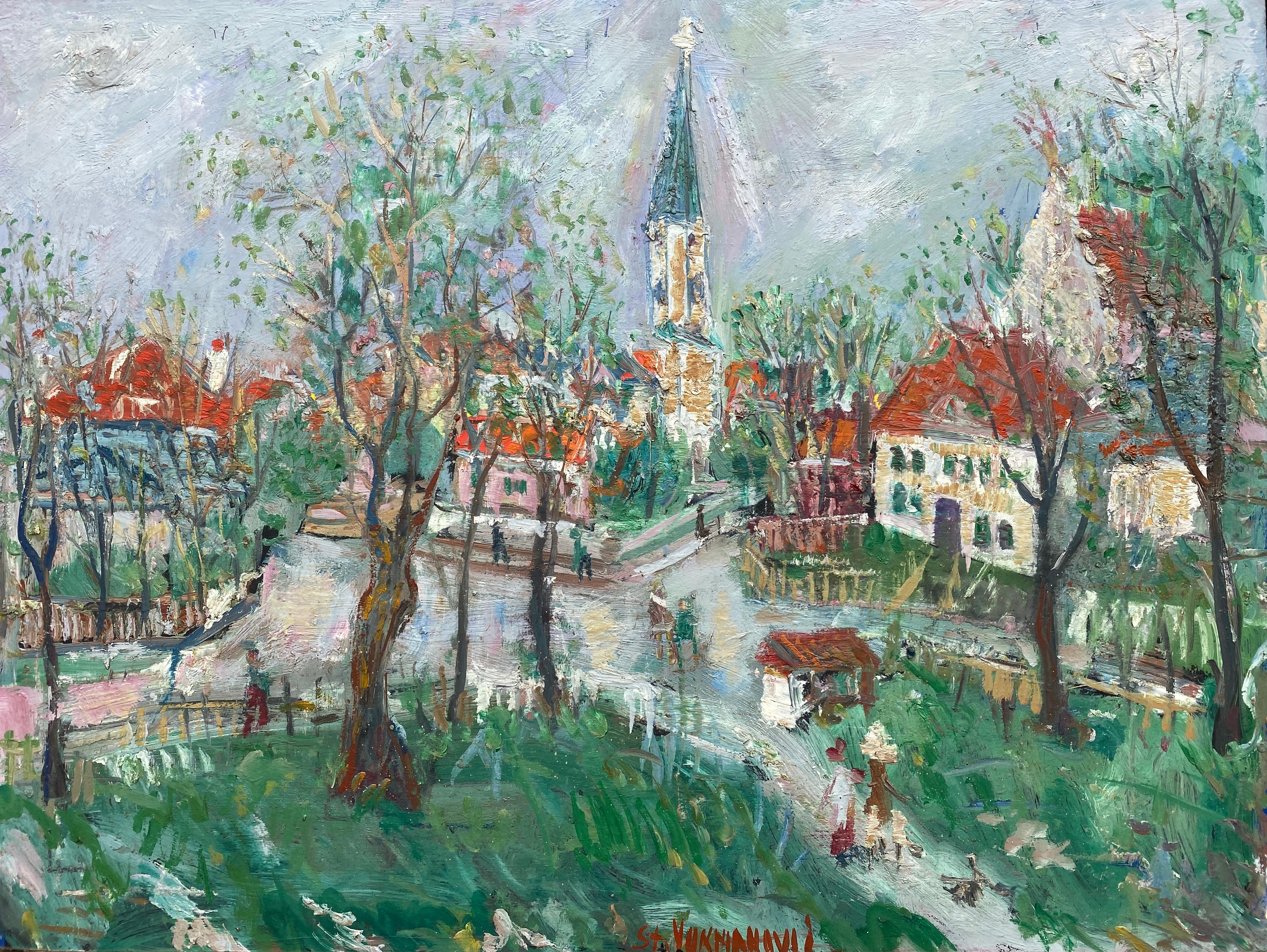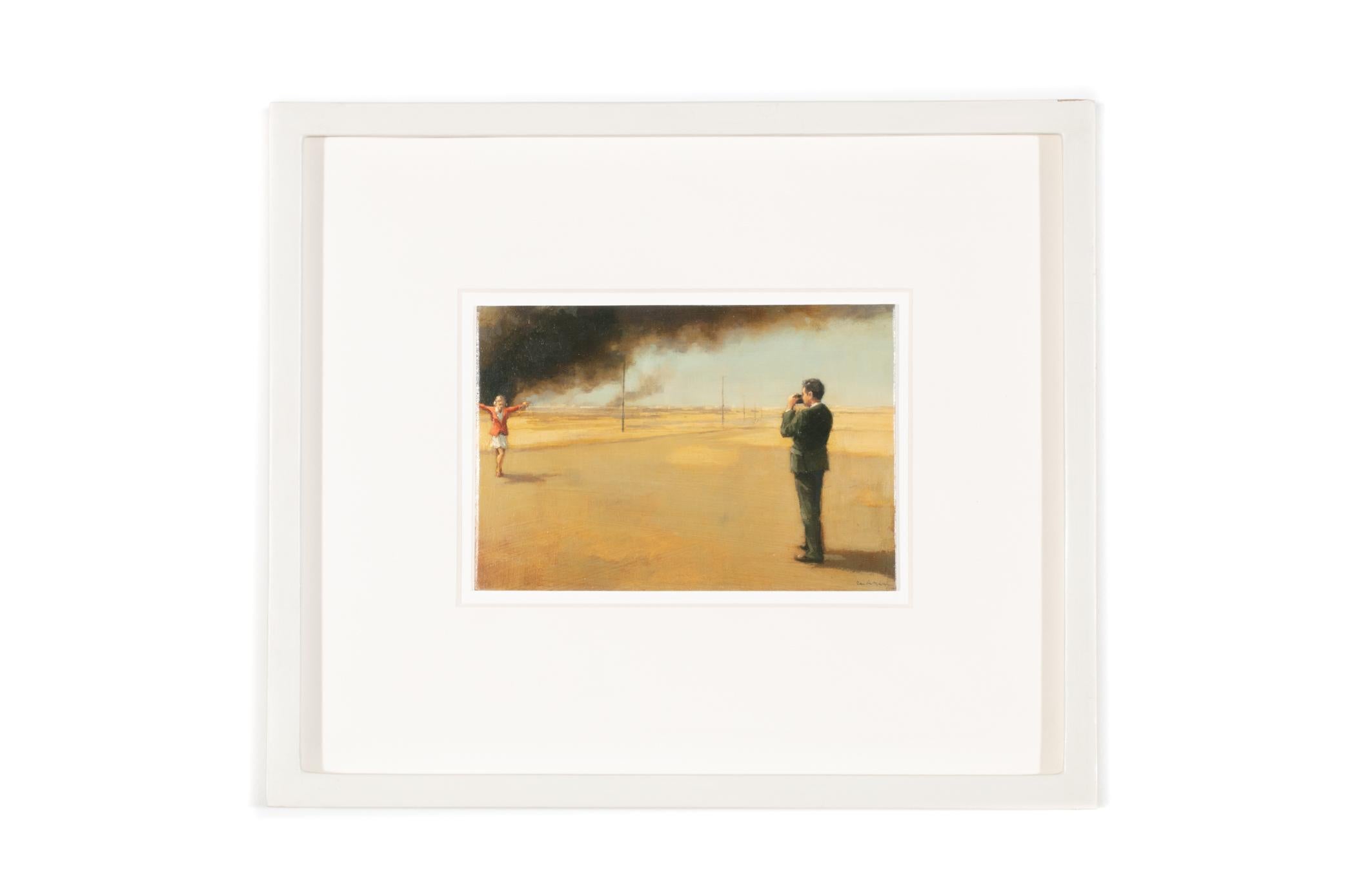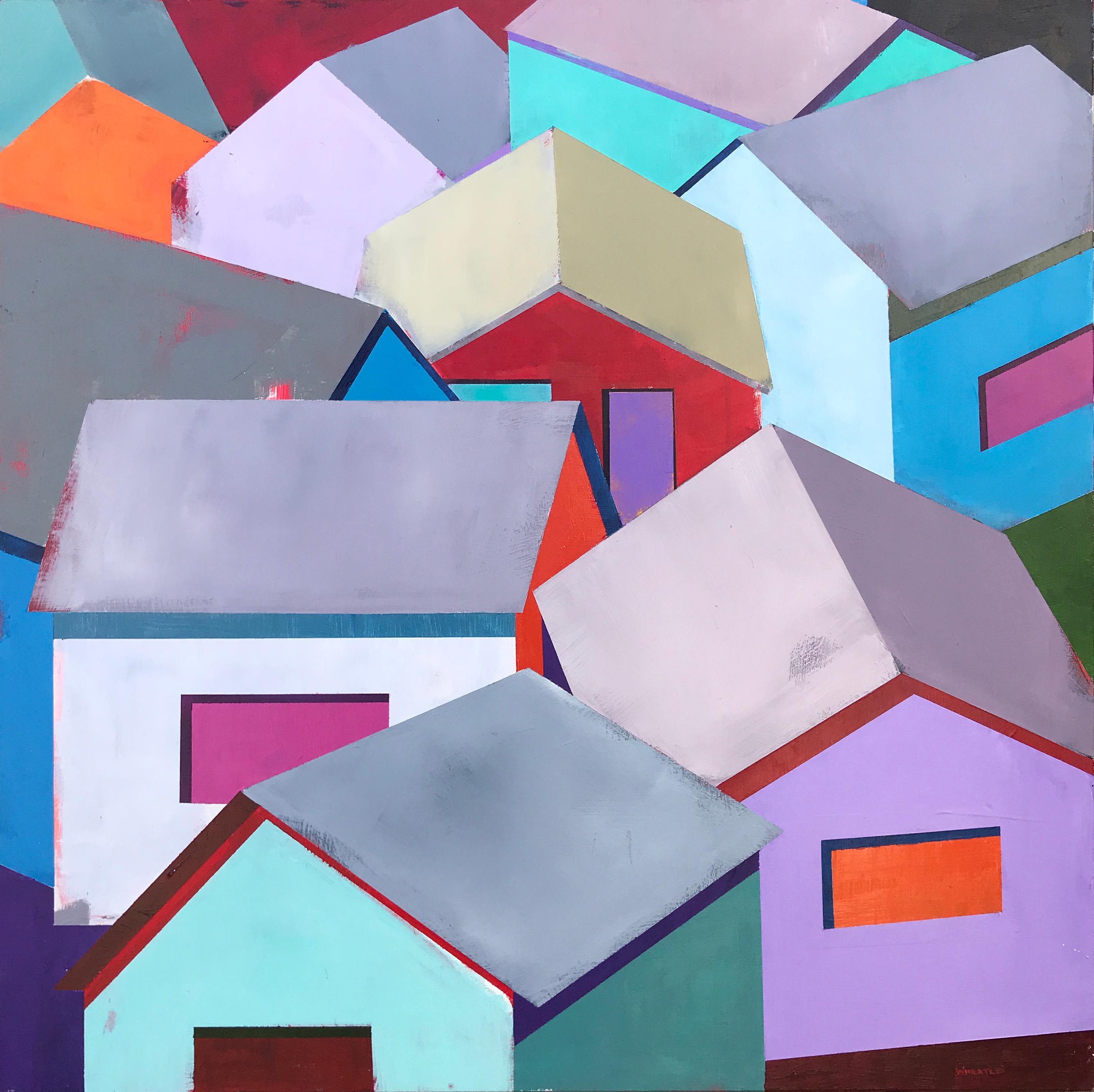Items Similar to Italian Modernist Surrealist Architecture Landscape Oil Painting Lazzaro Donati
Want more images or videos?
Request additional images or videos from the seller
1 of 12
Lazzaro DonatiItalian Modernist Surrealist Architecture Landscape Oil Painting Lazzaro Donati 1964
1964
About the Item
Lazzaro Donati (Italian, 1926-1977)
Oil on board. Colorful Architectural Italian Landscape. Porto Azzurro, 1964
Hand signed upper right. signed, titled on back of panel.
Dimensions: (Frame) H 37" x W 29", (Panel) H 27" x W 19"
Lazzaro Donati was born in Florence and attended the Academy of Fine Arts. He began to paint in 1953, and in 1955 held his first exhibition at the Indiano Gallery in Florence. Within three years eleven exhibitions followed in Italy, and as his reputation grew he was invited to give major exhibitions in London, Paris, New York, Chicago, Rio de Janeiro and Montevideo. He is considered one of the foremost contemporary Italian painters and his paintings hang in museums and private collections throughout the Americas, Europe and Asia. His work is recalling the works of the french Raoul Dufy, Dunoyer de Segonzac, Francois Gall and Jean Jansem. This particular work is reminiscent of the work of Manolo Valdes. Donati lived and worked at 24 Piazza Donatello in Florence, the square where generations of artists have created works worthy of the great Florentine tradition. As you entered the narrow hallway to his studio, a gilded life-size Venetian angel beckoned you to his door. Once inside, the present faded away and you found yourself in an atelier where early masters might have worked during the Renaissance. Within, luxurious Persian rugs set off the innumerable objects d’art and antique furnishings. Light poured in through the sloping glass wall on the north side. A dramatic stairway led to an overhanging balcony which served as a private gallery where the artist hung some of his favorite early works. To the left of the entrance was a smaller studio where Donati sculpted, with a window overlooking the famous old English cemetery where tourists laid flowers on the grave of Elizabeth Barrett Browning.
In the main studio itself, where Donati received his clients in an atmosphere as polished as an office of a top executive, one hardly realized that it was here that the artist actually painted. His easel was covered with Persian blue velvet, the painting on the easel was already framed, his chair was upholstered in red velvet and on his palette the colors were arranged with the precision of a Byzantine mosaic. In a corner stand were his latest works, framed and ready to be sent off to his next exhibition in Europe or America. He spoke fluent French and English as well as some Spanish and German. “After all”, he said, “you've got to know how to sell a painting to everyone.”
His early works indicated a momentary interest in surrealism modernism and abstract art; they were predominantly two dimensional, depending on line and strong color. Donati's painting cannot be classified as belonging to a particular school of painting. Speaking of his artistic inspiration, he said, “I am not conscious of having imitated or been influenced by any one particular painter, but every painting contains the experiences of many previous painters. No artist can paint without being influenced by masters like Raphael, Michelangelo, Titian, and outside Italy by artists like Rembrandt and Renoir.” In fact, in certain of his larger paintings with their Madonna-like figures and extensive landscape backgrounds, you can see the influence of Italian Renaissance painting, both in particular motifs and in the monumentality of conception. But in each case the original inspiration served only as the starting point for a wholly new and creative work of art.
Over the years he had worked on the same themes, transforming them with his own poetic vision. His most frequently recurring subjects, the nude, the still-life and the cityscape in part reflect his stylistic preference for rounded forms. “I paint the female form” he said, “not only because it is beautiful, but because it is basically round.” Another favorite subject is the cityscape, and again his taste for curved forms appeared in his choice of two domed churches, the Salute in Venice and Santo Spirito in Florence, both which he painted in innumerable versions in brilliant, vibrating colors.
The still-life was his third major theme. Time and again he drew his inspiration from a bowl of fruit, recreating it anew as his own style constantly developed and changed. With Donati, these few themes, which have recurred in the works of great masters in the history of painting, became in each case a new source of pleasure, a fresh way of seeing, and an insight into the creative vision of the artist.
His talents were not limited to painting. He was also a sculptor and an excellent photographer who published two books of his photographs in the Famous Cities of the World Series on Venice and Florence. He also held a doctor's degree in economics from the University of Florence.
- Creator:Lazzaro Donati (1926 - 1977, Italian)
- Creation Year:1964
- Dimensions:Height: 37 in (93.98 cm)Width: 29 in (73.66 cm)
- Medium:
- Movement & Style:
- Period:
- Condition:good. frame has minor wear. please see photos.
- Gallery Location:Surfside, FL
- Reference Number:1stDibs: LU38211721642
About the Seller
4.9
Platinum Seller
These expertly vetted sellers are 1stDibs' most experienced sellers and are rated highest by our customers.
Established in 1995
1stDibs seller since 2014
1,550 sales on 1stDibs
Typical response time: 1 hour
- ShippingRetrieving quote...Ships From: Surfside, FL
- Return PolicyA return for this item may be initiated within 3 days of delivery.
More From This SellerView All
- Venezuelan Surrealism Architectural Oil Painting Emerio Lunar Latin American ArtLocated in Surfside, FLProvenance: Galeria Durban Cesar Segnini, Caracas Venezuela. Emerio Dario Lunar was born on January 27, 1940 in Cabimas, Zulia state. Self-taught ...Category
1980s Surrealist Figurative Paintings
MaterialsCanvas, Oil
- French Mod Surrealist Commedia dell'arte Circus Scene Oil Painting J.P. SerrierBy Jean Pierre SerrierLocated in Surfside, FLJean Pierre Serrier (French, 1934-1989) Oil on canvas painting depicting four figures Hand signed lower right. Measures (frame) 26.5" x 30" wide, and (sight) 18.25." x 22.25" wide. Jean Pierre Serrier (1934 – 1989) was a French painter known for surrealism and absurdist art. Jean-Pierre Serrier was born in Montparnasse, Paris and attended the Académie des Beaux-Arts in Paris. the son of Louis and Solange Serrier. His father fought in World War II and became a prisoner of war. In 1940, as a six-year-old, he and his mother fled Paris for Corrèze in southwest France. Childhood memories of close escapes from German bombardments would later influence his absurdist philosophy of life. Passionate about drawing, in 1951 he applied and was admitted to the École nationale supérieure des arts appliqués et des métiers d'art in Paris. He shared an attic apartment in the 16th arrondissement with fellow student Jean-Baptiste Valadié. For income, he decorated shop windows. A trip to Spain provided motifs for early works. His student work might be characterized as art naïf (Naive art). While still a student, he sold a ceramic artwork to the poet and publisher Pierre Seghers, who would later commission drawings from him. He frequented jazz clubs in Saint-Germain des Près, and while listening to Sidney Bechet at the Vieux Colombier, he met his wife, Yvette.One of the last French Surrealist and follower of Nietzsche. His art conveyed the message to all of mankind that we are only human. The other Surrealist to center his art in philosophy was Rene Magritte whose paintings reflect his understanding of Sigmund Freud. He had his first exhibition in 1955, before being sent to Algeria to complete his military service. After graduating in 1955, he was drafted for military service, spent time in Germany and Morocco, and was sent to the front lines of the Algerian War. In 1959 he exhibited works at two Parisian galleries and at Juan-les-Pins on the Côte d'Azur. From 1961, he exhibited annually at the Salon des Artistes Français. In 1962, the City of Paris purchased his painting Un dimanche In 1961, Serrier made his first visit to the United States to exhibit at a New York gallery. In 1975 and 1979, he had successful exhibitions in New Orleans, and his work was included in art and news magazines, including Time and Newsweek. Beginning in the 1950s, his works included stylized portraits similar in some ways to the "big eyes" art of Margaret Keane, though it is uncertain that either artist influenced the other. Keane painted children, and so did Serrier, sometimes from life, but Serrier’s models are usually somewhat older, though uniformly slender and with androgynous features. A gallery owner introduced Serrier to American collectors Edgar Garbisch and his wife, Bernice Chrysler (daughter of Chrysler founder Walter P. Chrysler), who had a particular interest in naïve art; they commissioned a series of portraits from Serrier. At the same time, he met Reine Ausset in Paris, who in 1961 invited him to New York to take part in an exhibition at Galerie Norval on 57th Street. The show also included work by Moïse Kisling, and the exhibition program explicitly linked the two artists, saying that Serrier, who considered Moise Kisling "the Master," had found his own technique, but "the same vision joins the grand Kisling to the young Serrier: plenitude of shapes, sureness of palette, precision in outlines." In the 1960s he began painting slender, young, androgynous figures in groups, set in sparse landscapes with suggestions of the surreal and sometimes wearing costumes of the Commedia dell'arte. In some of these paintings the eyes of the figures are completely black, a motif that would continue in his later work. In 1965, he exhibited at Forest and Reed Gallery in London. Also in 1965, he discovered the small town of Martel, and with his old roommate Jean-Baptiste Valadié purchased a house that they opened as the gallery La Licorne (The Unicorn) in 1967. Responding to the political upheavals of May 1968 in France, and following the advice of Geneva gallery owner Roger Ferrero, Serrier's work became increasingly complex, idiosyncratic, and surreal. Imagery included the Tower of Babel, bodies suspended in space, and crowds of people all dressed alike, with identical features and entirely black eyes. Mannequins, playing cards, nudes, and levitating orbs also figured in the work. In a nod to Magritte, his men sometimes wear bowler hats. Another influence may have been the works of the Franco-Belgian surrealist Gaston Bogaert (1918-2008). Serrier's first major exhibit of these works, in Geneva in 1971, was titled Le Réalisme Fantastique. (Magic Realism) In 1972, he was made a member of the Société du Salon d'Automne, under whose auspices he was invited by the Polish government to exhibit in Warsaw in 1973, as part of a cultural exchange across the Iron Curtain. In 1976, he served on the jury of the Salon d'Automne. In 1975, New Orleans gallery owner Kurt E. Schon brought his work to several cities in the United States. A copiously illustrated monograph in English, Surrealism and the Absurd: Jean Pierre Serrier, was published in 1977. Author Thomas M. Bayer wrote: Serrier's world is one where—to use Friedrich Nietzche's term—the "human herd animal" is being confronted with the overwhelming task of coping with the world, his solitude, and at times, his resignation in the face of its monstrous size and duration. It is a world where the characterless, "blind" man faces the institutions, rules and symbols that made him into the being he now is…But Serrier does not lose himself in this world he portrays. He never forgets the old French tradition, the "black" humor, à la Molière. This classical humor at times is more felt than seen, in a manner that can be terribly funny, because it is horrifying, laughable, poignant and always true. Serrier told a friend, "In each of my paintings there's a message of hope amid the crowd of stereotypical figures. It could be an escaping dirigible, or a nymphet who flees like a deer under the red and blue trees of paradise...Category
Mid-20th Century Surrealist Figurative Paintings
MaterialsOil, Canvas
- Latvian Israeli Surreal Gouache Illustration Art Painting Tel AvivBy Maris BishofsLocated in Surfside, FLMaris Bishofs was born in 1939 in Rujiena, Latvia. In 1965 he became the first artist to graduate from the Latvian Art Academy with an interior design diploma. In 1972 he emigrated t...Category
1970s Surrealist Figurative Paintings
MaterialsGouache
- Latvian Israeli Surrealism Illustration Art Lithograph Screenprint Flying BaruchBy Maris BishofsLocated in Surfside, FLBARUCH, color screenprint, signed in pencil, numbered 5/175, sheet 25 ¾ x 21 ½”. Maris Bishofs was born in 1939 in Rujiena, Latvia. In 1965 he became the first artist to graduate fr...Category
20th Century Surrealist Figurative Paintings
MaterialsScreen
- Street Riot Oil Painting Mounted Police WPA artist Social Justice Americana ArtBy Arthur SmithLocated in Surfside, FLRiot, Revolution, Police figures on Horseback in City Streets. Hand signed lower right. Painting measures 6 x 12, framed 9 x 15 inches. Arthur Smith is a...Category
Mid-20th Century American Realist Figurative Paintings
MaterialsOil, Panel
- Julie Bozzi Americana Landscape Oil Painting Trompe L'oeil Frame Woman ArtistBy Julie BozziLocated in Surfside, FLJulie Bozzi (American, b. 1943) Hephaestus, 1989 oil on panel signed and dated (lower right) Provenance: Laura Carpenter Fine Art, Santa Fe The frame is just the panel painted in a f...Category
1980s Post-Modern Landscape Paintings
MaterialsOil, Panel
You May Also Like
- View of a Village Square, Stefan Vukmanovic, Belgrade 1924 – 1995 DegernauLocated in Bruges, BEView of a Village Square Vukmanovic Stefan Belgrade 1924 – 1995 Degernau Serbian Painter Signature: Signed bottom middle Medium: Oil on panel Dimensions: Image size 45 x 60 cm Biography: Vukmanovic (Vucmanovic) Stefan was born in 1924, in Belgrade, former Yugoslavia. He was a Serbian painter of landscapes and town scenes. Vukmanovic studied at the Munich Academy of Fine Arts with the master teacher and artist Charles Crodel (1894 – 1973). He was a member of the Munich Secession. In this statement of principles, the artists declared their intentions to move away from outmoded principles and a conservative conception of what art was. Throughout the 1930s, many political ideologies (Marxism, Socialism, Capitalist Democracy, Communism and Fascism) were engaged in struggles for dominance, and epitomised the political atmosphere of the era. Surrealism art...Category
20th Century Surrealist Landscape Paintings
MaterialsOil, Panel
- Réalisme Fantastique, L'Etabli, The Work Bench, Mid Century Fantasy SurrealistLocated in Cotignac, FRFrench, réalisme fantastique, Surrealist oil on board by Claude Verlinde. Signed and dated bottom left. Presented in plain wood frame with gilt filet. ...Category
1950s Surrealist Figurative Paintings
MaterialsPanel, Oil
- "Into the Night, " Oil PaintingLocated in Denver, COSara Scribner's (US based) "Into the Night" is an original, handmade oil painting that depicts a woman in a long pink dress walking towards a background ...Category
2010s Surrealist Figurative Paintings
MaterialsPanel, Oil
- Tomorrow We Will Cross A Vast SeaBy Gian Paolo DulbeccoLocated in Delray Beach, FLTomorrow we will cross a vast sea Gian Paolo Dulbecco Born in La Spezia (Italy) in 1941, he begins as a self-taught painter at the end of the 50s,...Category
1990s Surrealist Figurative Paintings
MaterialsOil, Panel
- Monday: 3 Down, Method of Removing Hair Roots (12)By Ben McLaughlinLocated in Saint Louis, MOBen McLaughlin Monday: 3 down, Method of removing hair roots (12), 2008 Oil on panel 6 3/4 x 4 1/2 inches (17.1 x 11.4 cm)Category
Early 2000s Surrealist Figurative Paintings
MaterialsOil, Panel
- "Huddling within Walls", Acrylic PaintingBy Justin WheatleyLocated in Denver, COJustin Wheatley's (US based) "Huddling within Walls" is an original, handmade acrylic painting that depicts many little houses of purple, blue, red, and pink all crowded together den...Category
2010s Surrealist Figurative Paintings
MaterialsAcrylic, Panel
Recently Viewed
View AllMore Ways To Browse
Italian Architecture Art
Oil Painting By Italian Painters
Figurative Architecture
Painting Italy Small
Italian Small Painting
Italian Architecture Painting
Oil Painting 1964
Early Modernist Painting
Art Architectural Large Size
Italian Oil Painting Large
Retro Italian Oil Painting
Large Italy Oil Painting
How To Sell
1960 Italian Paintings
Florence Italy Oil Paintings
Italian Oil Paintings Of Florence
Small Italian Oil Painting
Italian Oil Painting Small




